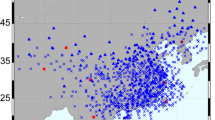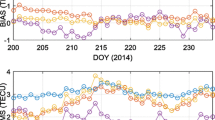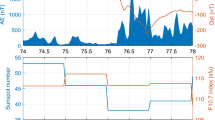Abstract
The International Reference Ionosphere (IRI) model is a widely used empirical model to describe ionospheric climatology. However, IRI represents the monthly averages of the ionospheric parameters, which makes it difficult to capture the local and short-term ionospheric variations. To overcome this limitation, we propose a data ingestion method using a combination of ground-based and space-borne observations. The ionospheric parameters from ground-based Global Navigation Satellite System (GNSS), ionosondes, space-borne GNSS radio occultation and satellite altimetry observations are ingested into the IRI-2020 model to improve its accuracy. The outputs of the ingested IRI (IRIinge) are assessed by case study and statistical analysis, with reference to independent ionosonde observations and global ionospheric maps. The case study shows that IRIinge expresses the diurnal and local variations of the ionosphere better than the standard IRI (IRIstan) in both high and low solar activity periods. The relative error of ionospheric electron density profiles from IRIinge is generally less than 10%, and the vertical total electron content from IRIinge has an accuracy improvement of 39.0% compared to that from IRIstan. The statistical analysis shows that IRIinge performs more stable than IRIstan, and its output generally has smaller REs and root-mean-square errors, especially in daytime and storm time. The proposed method significantly improves IRI-2020 on the accuracy of the output parameters and the ability to present the short-term variations of the ionosphere.
















Similar content being viewed by others
Data availability
The COSMIC and COSMIC-2 RO data are available from the COSMIC Data Analysis and Archive Center (CDAAC) (https://cdaac-www.cosmic.ucar.edu). The ionosonde data are from NGDC (ftp://ftp.ngdc.noaa.gov/ionosonde/data/). The GNSS data are from the Crustal Dynamics Data Information System (CDDIS) (https://cddis.nasa.gov/archive/gnss/data/). The satellite altimetry data are from the National Centers for Environmental Information (NCEI) (https://www.ncei.noaa.gov/products/jason-satellite-products). The IRI-2020 source code is downloaded at http://irimodel.org/.
References
Alizadeh MM, Schuh H, Todorova S, Schmidt M (2011) Global Ionosphere maps of VTEC from GNSS, satellite altimetry, and formosat-3/COSMIC data. J Geod 85(12):975–987. https://doi.org/10.1007/s00190-011-0449-z
Alizadeh MM, Schuh H, Schmidt M (2015) Ray tracing technique for global 3-D modeling of ionospheric electron density using GNSS measurements. Radio Sci 50(6):539–553. https://doi.org/10.1002/2014RS005466
Araujo-Pradere E, Weatherhead EC, Dandenault PB, Bilitza D, Wilkinson P, Coker C, Akmaev R, Beig G, Burešová D, Paxton LJ, Hernández-Pajares M, Liu JY, Lin CH, Habarulema JB, Paznukhov V (2019) Critical Issues in ionospheric data quality and implications for scientific studies. Radio Sci 54(5):440–454. https://doi.org/10.1029/2018RS006686
Bilitza D, Bhardwaj S, Koblinsky C (1997) Improved IRI predictions for the GEOSAT time period. Adv Sp Res 20(9):1755–1760. https://doi.org/10.1016/S0273-1177(97)00585-1
Bilitza D, Brown SA, Wang MY, Souza JR, Roddy PA (2012) Measurements and IRI model predictions during the recent solar minimum. J Atmos Solar-Terrestrial Phys 86:99–106. https://doi.org/10.1016/j.jastp.2012.06.010
Bilitza D, Pezzopane M, Truhlik V, Altadill D, Reinisch BW, Pignalberi A (2022) The international reference ionosphere model: a review and description of an ionospheric benchmark. Rev Geophys 60(4):e2022RG000792. https://doi.org/10.1029/2022RG000792
Brown S, Bilitza D, Yiğit E (2018) Ionosonde-based indices for improved representation of solar cycle variation in the international reference Ionosphere model. J Atmos Solar-Terrestrial Phys 171:137–146. https://doi.org/10.1016/j.jastp.2017.08.022
Brunini C, Azpilicueta F, Nava B (2013) A technique for routinely updating the ITU-R database using radio occultation electron density profiles. J Geod 87(9):813–823. https://doi.org/10.1007/s00190-013-0648-x
Habarulema JB, Ssessanga N (2017) Adapting a climatology model to improve estimation of ionosphere parameters and subsequent validation with radio occultation and ionosonde data. Sp Weather 15(1):84–98. https://doi.org/10.1002/2016SW001549
Hernandez-Pajares M, Juan JM, Sanz J, Bilitza D (2002) Combining GPS measurements and IRI model values for space weather specification. Adv Sp Res 29(6):949–958. https://doi.org/10.1016/S0273-1177(02)00051-0
Komjathy A, Langley RB, Bilitza D (1998) Ingesting GPS-Derived TEC data into the international reference ionosphere for single frequency radar altimeter ionospheric delay corrections. Adv Sp Res 22(6):793–801. https://doi.org/10.1016/S0273-1177(98)00100-8
Kumar A, Haralambous H, Kumar S (2022) Comparison of bottomside ionospheric profile parameters (B0 and B1) extracted from FORMOSAT-7/COSMIC-2 GNSS radio occultations with digisondes and IRI-2016 model. Adv Sp Res 70(4):1121–1141. https://doi.org/10.1016/j.asr.2022.05.045
Liang W, Limberger M, Schmidt M, Dettmering D, Hugentobler U, Bilitza D, Jakowski N, Hoque MM, Wilken V, Gerzen T (2015) Regional modeling of ionospheric peak parameters using GNSS data—an update for IRI. Adv Sp Res 55(8):1981–1993. https://doi.org/10.1016/j.asr.2014.12.006
Liu RY, Smith PA, King JW (1983) A new solar index which leads to improved foF2 predictions using the CCIR Atlas. Telecommun J 50(8):408–414
Liu JY, Lin CY, Lin CH, Tsai HF, Solomon SC, Sun YY, Lee IT, Schreiner WS, Kuo YH (2010) Artificial plasma cave in the low-latitude ionosphere results from the radio occultation inversion of the FORMOSAT-3/COSMIC. J Geophys Res Sp Phys 115(7):A07319. https://doi.org/10.1029/2009JA015079
Liu L, Yao Y, Zou S, Kong J, Shan L, Zhai C, Zhao C, Wang Y (2019) Ingestion of GIM-derived TEC data for updating IRI-2016 driven by effective IG indices over the European region. J Geod 93(10):1911–1930. https://doi.org/10.1007/s00190-019-01291-5
Migoya-Orué Y, Nava B, Radicella S, Alazo-Cuartas K (2015) GNSS derived TEC data ingestion into IRI 2012. Adv Sp Res 55(8):1994–2002. https://doi.org/10.1016/j.asr.2014.12.033
Pedatella NM, Yue X, Schreiner WS (2015) An improved inversion for FORMOSAT-3/COSMIC ionosphere electron density profiles. J Geophys Res Sp Phys 120(10):8942–8953. https://doi.org/10.1002/2015JA021704
Pignalberi A, Pezzopane M, Rizzi R, Galkin I (2018) Effective solar indices for ionospheric modeling: a review and a proposal for a real-time regional IRI. Surv Geophys 39(1):125–167. https://doi.org/10.1007/s10712-017-9438-y
Ren X, Chen J, Zhang X, Yang P (2020) Topside ionosphere of NeQuick2 and IRI-2016 validated by using onboard GPS observations from multiple LEO satellites. J Geophys Res Sp Phys 125(9):e2020JA027999. https://doi.org/10.1029/2020JA027999
Schaer S (1999) Mapping and predicting the earth’s ionosphere using the global positioning system. University of Bern, Switzerland
Shubin VN (2015) Global median model of the F2-layer peak height based on ionospheric radio-occultation and ground-based digisonde observations. Adv Sp Res 56(5):916–928. https://doi.org/10.1016/j.asr.2015.05.029
Wu K-H, Su C-L, Chu Y-H (2015) Improvement of GPS radio occultation retrieval error of E region electron density: COSMIC measurement and IRI model simulation. J Geophys Res Sp Phys 120(3):2299–2315. https://doi.org/10.1002/2014JA020622
Wu MJ, Guo P, Fu NF, Hu XG, Hong ZJ (2018) Improvement of the IRI model using F2 layer parameters derived from GPS/COSMIC radio occultation observations. J Geophys Res Sp Phys 123(11):9815–9835. https://doi.org/10.1029/2018JA026092
Yao Y, Liu L, Kong J, Zhai C (2018) Global ionospheric modeling based on multi-GNSS, satellite altimetry, and formosat-3/COSMIC data. GPS Solut 22(4):104. https://doi.org/10.1007/s10291-018-0770-6
Yao Y, Chen X, Kong J, Zhou C, Liu L, Shan L, Guo Z (2021) An updated experimental model of IG12 indices over the antarctic region via the assimilation of IRI2016 with GNSS TEC. IEEE Trans Geosci Remote Sens 59(2):1700–1717. https://doi.org/10.1109/TGRS.2020.2999132
Yue X, Schreiner WS, Rocken C, Kuo YH, Lei J (2012) Artificial ionospheric wave number 4 structure below the F2 region due to the Abel retrieval of radio occultation measurements. GPS Solut 16(1):1–7. https://doi.org/10.1007/s10291-010-0201-9
Acknowledgements
This research is funded by the National Natural Science Foundation of China (Nos. 42074027, 42174017, 41774033, and 41774032).
Author information
Authors and Affiliations
Contributions
TH and XX designed the research. TH performed the experiments. TH, XX and JL analyzed the data. TH and XX wrote the draft of the manuscript. All authors reviewed and approved the final manuscript.
Corresponding author
Ethics declarations
Conflict of interests
The authors declare no competing interests.
Additional information
Publisher's Note
Springer Nature remains neutral with regard to jurisdictional claims in published maps and institutional affiliations.
Rights and permissions
Springer Nature or its licensor (e.g. a society or other partner) holds exclusive rights to this article under a publishing agreement with the author(s) or other rightsholder(s); author self-archiving of the accepted manuscript version of this article is solely governed by the terms of such publishing agreement and applicable law.
Springer Nature or its licensor (e.g. a society or other partner) holds exclusive rights to this article under a publishing agreement with the author(s) or other rightsholder(s); author self-archiving of the accepted manuscript version of this article is solely governed by the terms of such publishing agreement and applicable law.
About this article
Cite this article
Hu, T., Xu, X. & Luo, J. Multi-source data ingestion for IRI-2020 model: a combination of ground-based and space-borne observations. GPS Solut 28, 78 (2024). https://doi.org/10.1007/s10291-024-01620-y
Received:
Accepted:
Published:
DOI: https://doi.org/10.1007/s10291-024-01620-y




